Four-image NAVCAM montage comprising images taken on 14 September from a distance of 30 km from comet 67P/Churyumov-Gerasimenko (reminder: the distance is given to the centre of the comet).
This is how the comet looked to Rosetta’s navigation camera last Sunday, when experts from ESA, DLR, and CNES were gathered in Toulouse, France, to choose the primary and backup landing sites for Philae.
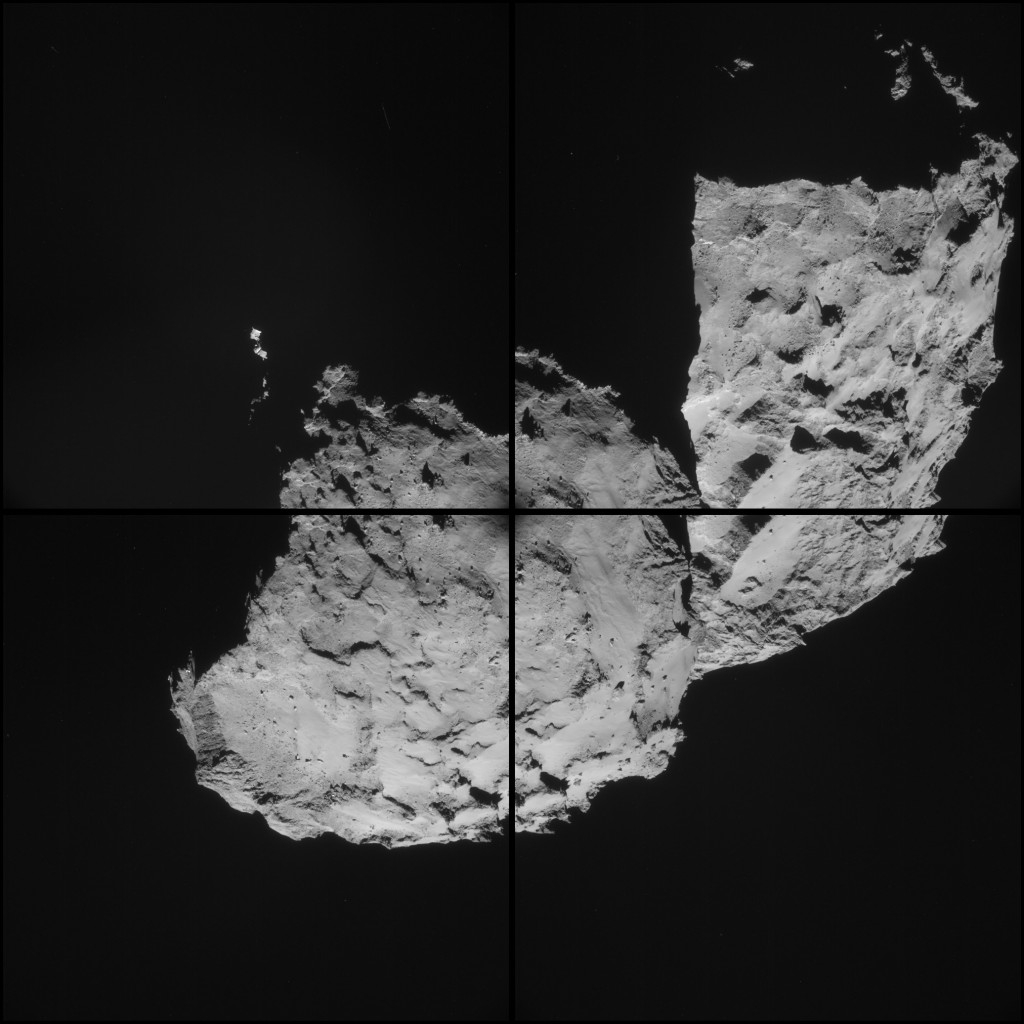
Four image montage of comet 67P/C-G, using images taken on 14 September. The four images are shown separated by black borders and there is some overlap between adjacent frames, so that some features appear in more than one image. Credits: ESA/Rosetta/NAVCAM
This is a mosaic obtained by combining the four frames, rotating by 180 degrees and cropping it. Site J, the primary landing site that was chosen for Philae, is visible towards the top-middle of the smaller head at the top of the rotated image, while the backup landing site, C, is on the lower-left side of the main body.
At this distance, the resolution of NAVCAM is roughly 2.5 metres per pixel. The phase angle in the image is 61.5 degrees.
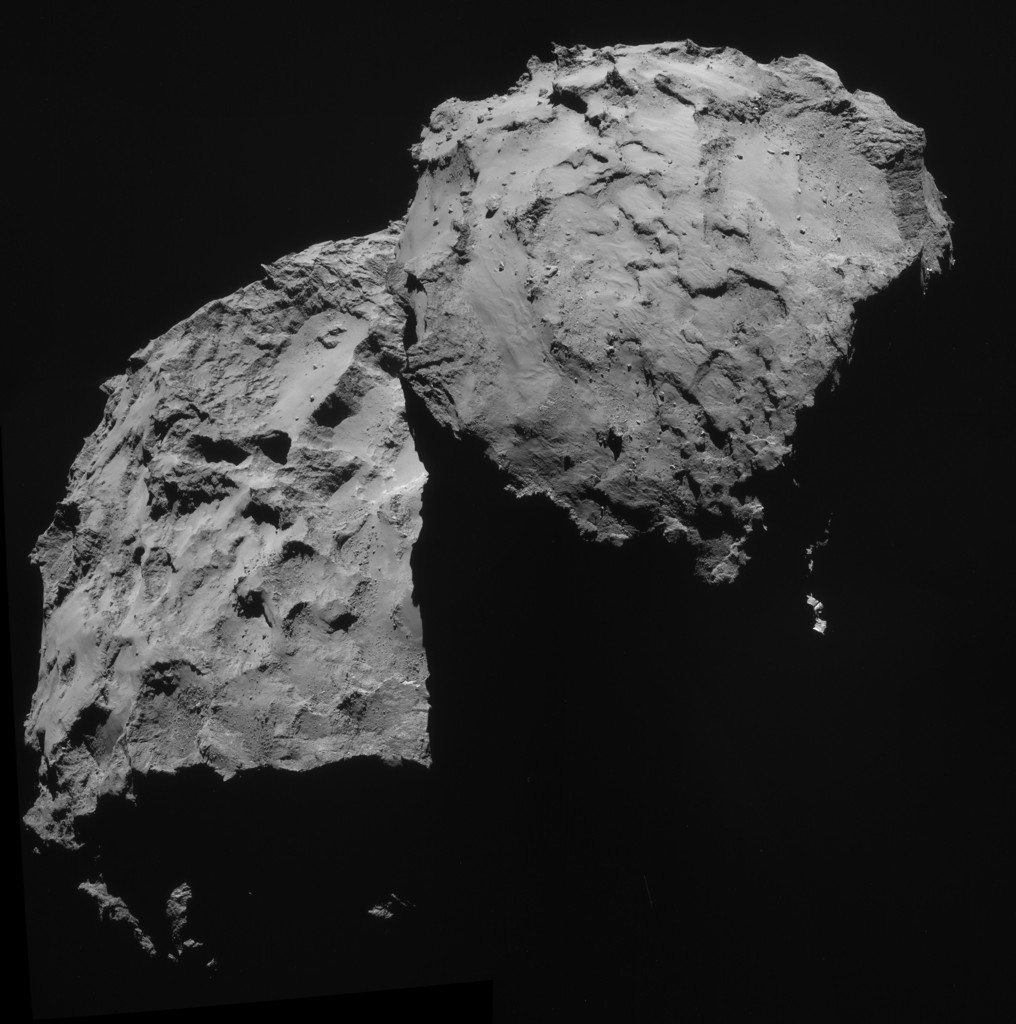
Four image mosaic of comet 67P/C-G, using images taken on 14 September (rotated by 180 degrees and cropped). Credit: ESA/Rosetta/NAVCAM
The four individual frames are also provided below (for more information on this presentation of images see the earlier blog post: CometWatch Update). As before, you are welcome to explore these images, make your own mosaics and share the links on this blog.

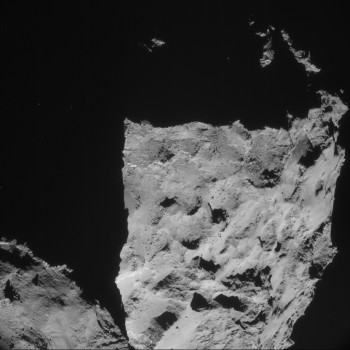
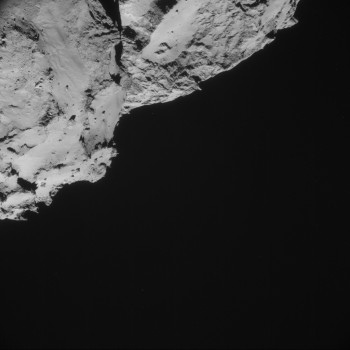
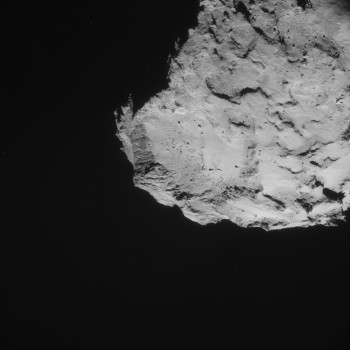
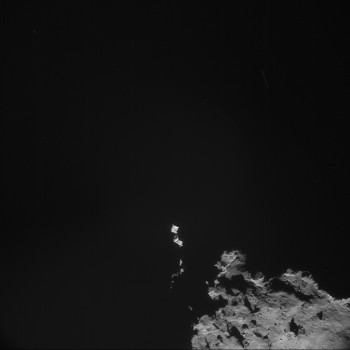








Discussion: 56 comments
These pics are really amazing, every day something new to astound us. BRAVO to everybody asscoiated with this mission. But I do wish that with all the money spent on this project there had been a little left over for a camera to take pictures in colour.
Seriously, well done everybody!
which color can be on a comet?
I think, in order to experience the comet in color, we would have to paint it first.
John — For a spectacular “reconstructed color” image of the 05 September OSIRIS black & white image, see
https://apod.nasa.gov/apod/image/1409/cometCG01_rosetta_2048.jpg
There are 2 OSIRIS cameras — a narrow-angle and a wide-angle. Both are equipped with spectral filter wheels that include Red/Green/Blue filters among other filters. For more information, check out
https://www.planetary.org/explore/resource-library/data/rosetta-osiris.html
Are there any more amazing colour photos we can see?
The scientific cameras (OSIRIS) have color filters, so I hope we will see some color pictures in the future. Not sure if there is much color to see there, however.
There are pictures in colours available ranging from UV to NIR, (240nm to 1000nm), although in the visible range its senseless to use different colours of charcoal.
https://pdssbn.astro.umd.edu/holdings/ro-a-osiwac-3-ast1-steinsflyby-v1.4/document/osiris_ssr/osiris_ssr.pdf
In the spec at page 20 you can read what the purpose is using colour filters in the camera.
If fancy pictures are wanted they can be created in photoshop and serves only for an artists view.
Not sure it would have been that well spent. I thought there was general agreement that nearly the only colour is black:
https://www.universetoday.com/114034/what-comets-parking-lots-and-charcoal-have-in-common/
The apparent brightness of the sunlit areas is merely the result of simple image editing, to contrast with the surrounding dark.
The only genuinely white areas on the whole surface – the white-hot regions of the neck where electric discharge phenomena are arguably shooting out those spectacular jets (https://www.flickr.com/photos/alpi-costerni/15149831901/) – were only shown fleetingly in early NAVCAM images. I’m increasingly worried by the complete absence ever since of any OSIRIS images of this most intriguing of all areas of the comet. Is there any guilty secret about this area being hidden from us or is simply that the intensity of the electric arcs just can’t be imaged close-up?
The ‘white’ parts of the comet shown on the images aren’t actually white nor are they ‘white-hot’. The images are processed to stretch the dynamic range so the less dark areas become white and the darkest areas stay ‘black’ and to our eyes it looks more normal (hence the term ‘normalisation’ for this type of image processing). I’m not sure what you think are electric arcs, that sort of activity isn’t what gives rise to a jet; it’s the sublimation of ices that fuels the gas and dust tails.
The color is black.
OSIRIS please!
My take on this mosaic:
https://www.flickr.com/photos/105035663@N07/
Marvelous cliffs and peaks!
‘Cry me a river’ bed to the left of landing zone 😉
Will erupt this time?
Can’t conceive millibars of gas doing this dunes pattern.
Colour? The comet is blacker than a black t shirt and reflects only 2-3% of the sunlight that falls upon it. The images you see are only after considerable processing. how many shades of black would you like to see?
Kind of ‘dust terraces’ all over the place.
Why should they be “dust” terraces? It seems, telling by the shadows being cast by the numerous large and small boulders which are strewn all over the comet, that the boulders are sitting squarely on top of whatever these surfaces are made of. This suggests that the “terraces” are extremely hard, perhaps made of glassified silicates. If it were a question of “dust”, many of the boulders would have sunk into it to varying degrees and many of the shadows would hence look much less distinct.
Hi THOMAS. Worried as you at the ‘dripping’ of data. But won’t like to distract the teams. By now, in this orbit, they are seeing incredible things. Sure there are multi vectorial pressures on them. Best hopes for openness and truthfulness.
I agree with you entirely, Logan. I just hope they would share some more of the incredible things they are seeing with us.
on these images some prominent features on both “head” and “body” are “soft plains” (with some boulders) and steep “cliffs”, vertical more or less to a gravitational centre. are the sinkholes? other term?
Do you see dept of dust deposit on upper left ‘crater’?
And some underlying cells looks ‘clean’. Maybe expelling gas.
No, I don’t see any depth of dust at all. On the contrary, the boulders are sitting on top of it…
John, the OSIRIS camera is fully equipped to take color images. (And more)
It takes images trough various filters that let trough different parts of the light spectrum. If you combine images taken with different filters you can assemble color images. (One would also have to reproject the individual frames over a shapemodel to get the best results scince the spacecraft and comet is moving between each shot taken)
The OSIRIS cameras do not use exactly the same filters as a conventional camera so you will have to do some rather advanced colorimetric processing to get a true color image.
The OSIRIS team are probably way too busy to have time to do that kind of thing just to please the public at this point in the mission.
Yes, the OSIRIS team and also the other teams are working hard. But it would be nice if they could a least publish on the ESA website in full resolution and detail the products they have prepared for conferences and media events. I don’t understand why this should not be possible.
But conceive ‘dust avalanches’;)
Maybe dust and gas impacting in particular vectors are causing electric fields. This process is gigantic in the neck, by example. This could explain the coincidence of both coldness and plasma flow there.
Considering coma size this process could be orders of magnitude greater than solar wind
Amazing picture, with -I think- great view of the J landing site. Thanks for continuing to share this material.
Could some of those ‘metallic’, smooth boulders be CO2?
With contrast increased we can see two faint jets:
https://www.flickr.com/photos/105035663@N07/15083544708/in/photostream/
Nice picture Thomas,
the (just visible) jet coming vertically from the top of the picture is very parallel, it also look like it is coming from a crater thats the same diameter as the width of the jet. Unfortunately we cant really see if this is true.
I think I will need to check other pictures to check there is a crater there.
To me this looks like photoshop image manipulation with a circular brush
After looking for a needle in a haystack for about a week, now i found an update of the comets period of rotation to be 12.4043 +/- 0.0007 hours. Say 12 hours and 24 minutes. Thats great news if any. Im still searching for better accuracy concerning the mass and the volume plus size. It is possible that ESA already have those figures on hand but do not consider this as important information to share with the public. The period of rotation will change a bit during the comets orbit around the sun due to several factors. One can be predicted and that is its angular change of increasing velocity in its elliptical orbit approaching the sun, thats easy calculation. Another can be estimated and that is its loss of rotational momentum as it develops a coma. That’s a bit of guesswork, a bit of history research and some prediction. Then a great uncertain factor is the big surprise if it decides to split in two or some other catastrophic scenario, that is for the nightmare. All in all a change from 12.7 to 12.4 hours of periodic rotation time is a significant change so are its figures of accuracy and resolution.
What is extraordinary in this image is not the relatively flat, lighter-coloured areas which some on this blog are calling “plains”, but the clearly visible nature of the rocky outcrops (cliffs, slopes or pinnacles). On the left part of the image in particular (which is the “chest” part of the “body” region which overlooks the “neck”) it should be observed that the rock is consistently fissured into strata which resemble a “sedimentary rock” formation. Crucially, over the several hundred metres width which this left part of the image represents, ALL of the strata (starting with those of the spectacular peak jutting up on the “skyline”) are aligned with exactly the same orientation, in a roughly ten o’clock position, pointing to the base of the neck.
This thus seems to confirm the hypothesis I recently suggested on the “A PRELIMINARY MAP OF ROSETTA’S COMET » blog of 08/09/2014, where I concluded my “10/09/2014 at 15:26” post by commenting:
“I referred above, in my comments on recent posts […], to what appears to be a sedimentary rock formation making up the underside of the “head” region of the comet (i.e. on the very broad “chin” area as seen from below). It would certainly have been immediately categorized as such if it had been observed on Earth (particularly in the light of the astonishing Osiris 3D image:
https://www.esa.int/spaceinimages/Images/2014/08/Rosetta_s_comet_in_3D).
Has anyone seen any similar images of the cliff-face on the other side of the “neck” which divides the head from the body (as if the Osiris image above had been taken from the opposite side of the canyon)? If the upper “chest” side of the “body” facing the underside of the “chin” were to show some sort of corresponding rock strata, aligned in the same direction, that would start to become even more intriguing…
If no such images exist yet , perhaps Osiris will be coming up with them in a few days time. I can’t wait!”
Finally it’s the above NAVCAM image which provides the evidence I was looking for: the apparently perfect alignment of the “sedimentary rock” strata on either side of the chasm represented by the “neck”. This comet thus indeed seems to be a 4-kilometre long chunk of rock which was torn bodily from one of the rocky inner planets in an indeterminate past.
How about the phrase “asphalted gletcher” as opposed to “dirty snowball”? Seems more appropriate… Or maybe “pitch glaced iceberg”?
Hi Jacob. Could you help us understand extending this ‘gletcher’ idea?
Some parts of the nucleus are steep and striated “cliffs” that visually reminds me of the way gletchers break apart: like if a dense and stiff crust is losing support from a collapsed below. I am not hinting at any chemical composition, just the mechanical structure and appearance.
Glazed…
We see logarithmic; only minus infinity is black – i.e. it’s all relative. Not expecting the unexpected (colour) is no reason not to look for it, at least sometimes – commensurate with mentioned bandwidth limitations (data & people). More interesting colour patterns are there in the detail? Please continue to engage and intrigue us general public with more enhanced-colour photo-candy!
You Have the point, David Esp. Black is not a color. Of course we could have an approximation of a chromatic view if a virtual ‘light spot’ used on the surface.
The Osiris cameras have colour filters an could present synthetic colours to make fancy pictures for the audience but its not supposed to do that. the spectral range from UV to NIR and filter-set is for analysing properties of the surface.
The navcam has no filter so black and whit it is.
With photoshop and an artists skills you get what you want.
I wonder how big Philae is compared to say those two boulders. Would Philae be visable in this photo.
While looking at some older images of comet 67P/Churyumov-Gerasimenko, my wife came by behind me and said in Spanish “roseta”, and walked on by. Now she is not interested in comets, or space and had no knowledge of the “Rosetta “Rosetta” program and she said in English. “no, that thing( images of the comet) looks like popcorn, and we call popcorn “roseta” in Guadalajara.
Just a funny coincidence?
I also wonder if anyone has any thoughts weather this shape is due to two commets being stuck together at the neck, or if this object was once round and parts have worn away (due to various comet processes) that have left this shape
I think your second suggestion is much more likely: the probability of two distinct comets originating from different parts of the theorized Oort cloud being ejected towards the inner solar system (as standard theory would have it) and then somehow coming within slow-motion kissing distance of each other and sticking together, at the very moment when humans happened to send Rosette to get a close-up of any random passing comet (even allowing for the 20-year planning process and the 10-year trip) is presumably something like a chance in billions of billions of billions or even less (even if the process were actually possible…).
Your second suggestion could, IMHO, be much closer to the mark, except that this comet was probably never really “round”: the pictures coming in suggest that it was originally a rather elongated lump of what looks like sedimentary rock, which has indeed since been “worn away” in its middle section by one of the “various comet processes” you refer to, to form the current “neck”. What is really striking, in this connection, is just how smooth the neck region is.
And strikingly, the same process is clearly also at work, presumably at an earlier stage of neck formation, on one of the other rocky-looking comets we have acquired images of (67P is only the sixth…), Hartley 2, which also displays a smooth, broad “waist” (but not yet “neck”) with, at either end, two much rougher-looking lobes:
https://www.nasa.gov/centers/jpl/news/epoxi20101104_prt.htm
Hartley 2 might also, like the Rosetta comet 67P, eventually turn into a rubber duck, a champagne cork or an uprooted morel mushroom (as you look at it, according to your age and your lifestyle…).
Even the apparently rotund rock Tempel 1, of “Deep Impact” fame, sports a pretty convincing narrow waist-band, as if it were wearing a very tight belt, when you look closely at the images:
https://apod.nasa.gov/apod/ap050915.html
But why?
Crime experts talk about “pattern recognition”. When you see several smoking guns pointing in the same direction, then there’s an odds-on chance that they have something in common and that there’s going to be something dead (like the standard “dirty snowball” comet theory) at the end of the day. You just need to recognize the pattern.
Great pic! Did a bit of work on it and spotlighted some fascinating features.. can’t wait to see proper OSIRIS views of these, but I suppose we’ll have to… 🙁 https://cumbriansky.wordpress.com/2014/09/18/a-tour-of-67p/5226
Too surprised that comets are nothing more than galactic trash bags?
If you were a passenger on Rosetta, you would have a bright and starry view, except in one directiion, and there would be a sinister black patch where no stars shine at all. 67P would look like a featureless black hole, where stars would diappear on one side and re-emerge an hour or two later on the other side.
Even the sun, 3.AUs distant, will disappear behind this spooky black curtain and to the human eye no corona will be visible.
The night view is something to look forward to.
From planet earth the comet has a magnitude of 19 that means 160000 weaker then the human eye can detect. But getting 400 times closer the human eye will be able to see it. And by then it sees the coma at first. Going even closer also the nuclei will reach a size for the human eye to detect and to observe it from rosettas position is easy doing. After all it reflects 3% of the sunlight that still is intense enough to provide solar photovoltaic energy The navcam is not as sensitive as the human eye. And its field of view is only 5 degrees.
5 degrees, low sensitivity, 3% reflectivity subject, 500 pixels, no filters… Thanks a lot again NAVCAM team. Taking the time to ‘dance’ with such a limited instrument. And for sharing the joy of discovery as it is happening.
🙂
Please, tell us about surface Iron, and magnetic resistance on the nucleus.
Plasticity is a lot more evident in the body that in the head.
Beautifully sampled the structures on the right side of the head crater in
https://www.esa.int/var/esa/storage/images/esa_multimedia/images/2014/09/comet_on_14_september_2014_-_navcam/14828095-3-eng-GB/Comet_on_14_September_2014_-_NavCam.jpg
; kind of ‘cocked bread cells’.
And experienced microscopist could give a lot of ideas.
Of course “asphalted” hints at the color and probable chemical nature of a dry black crust on a frozen and sublimating interior.
Question is there water/ice or not?
https://blogs.esa.int/rosetta/2014/09/15/miro-bathes-in-water-vapour/
BUT with the latest images claiming there is only dust no ice no water. If no water then what was measured? Do we have to go back and check all the Microwave data?